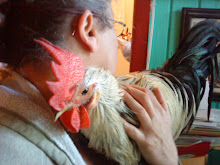Okay, so this post is really a cheat 'cause I don't want to lose track of an article that relates to my enduring desire to overly examine and intellectualize every aspect of my birds' behavior:
http://dustincurtis.com/how_niko_tinbergen_reverse_engineered_the_seagull.html
In this case, the writer is reporting on a researcher's work determining what actually inspires a seagull chick to peck at mama's beak (and thus receive a tasty barf-meal). It's a wonderful read whether you care about the explanation or not, but my ham-handed summary goes something like this: Baby Gull isn't looking for Mama Gull, but rather is hard-wired to get really excited about anything elongated with a spot of high contrast. (Please read the article for the fascinating details.) Curtis (the author) is excited by this work because it demonstrates "elastic triggers" in biology, and he sees mind-boggling (to my mind, anyway) applications to computer programming/software design. (Are those the same thing?)
Anyway, for me this is really exciting because it helps explain the behavior that I observe with my very cloistered and domesticated roosters (in contrast to what I recall with the more free-range roos from the ranch). And that is the response to what I'll call the "hawk trigger."
At the ranch, once in a while, a call would go up. It's been so long since I've heard it, but let's just say that it sounds like anxious, urgent, rusty trumpets. The sound is far, then gets closer and closer, as roos that are nearer pick up the call. Every time, I would look up, and eventually a hawk would appear.
Now the social cooperation in this example is impressive enough and worthy of its own discussion, but when I started taking my flockless home-raised roos outside, I noticed a similar, untutored, wariness of the sky. There's a sound that a worried rooster makes that is unmistakable, and what's interesting is that it can be set off by a butterfly or an airplane or a crow . . . or a hawk.
So I used to spend a fair amount of time with each, outside, looking at the sky (roos are great bird-watch partners), going, "oh, that's a crow. . . . oh silly, that's a little bird . . . ohhhhhhhhhhhhh, that's a hawk." But the hawk appeared only occasionally. It was clear that they were reacting to something, which could or could not be a hawk, but which in any case was something to be watched (the hawk trigger).
I had become so accustomed to this "oh, that's a crow" conversation that a couple of days ago when Fleck totally freaked out in the yard--flapping about and squawking as though he were battling an imaginary opponent--I looked up into the nearby trees expecting to see something really really scary in the branches. I turned my head a bit further south, and there it was, the threat: a Metlife blimp (for the "if" in life).
Needless to say, a blimp looks nothing like a hawk--unless we're talking elastic triggers. So chickens (especially roos--that's another story: heads-up time of roos vs. hens) are hard-wired to see something moving over them in the sky as a threat. And my guess is that a flock is a lot better than I am at refining that "instinct" to focus on hawks and not butterflies.
It also helps explain why I can herd a cocky cock with a broom or dustpan raised overhead--same trigger. It may even explain the submissive behavior that occurs when something (another roo, my hand) is immediately above a bird (let's play dead?).
And of course what's also important is what this says about our own behavior. (We gaze at the t.v., the computer, the cell phone, because "nature" told us that light is good?)
Light a candle. Happy New Year.
Thursday, January 1, 2009
Subscribe to:
Post Comments (Atom)

1 comment:
As it pertains to us humans...I think you may have stumbled on a way to get students to read-attach book lights to their text books! ;-)
Really, that is a very interesting observation.
Post a Comment